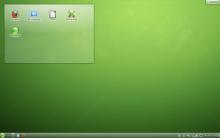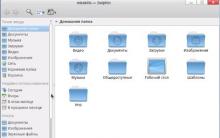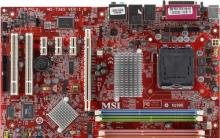Time flies, and nothing stands still. On April 21, 2016, the release of a new version of Ubuntu Server 16.04 LTS Xenial Xerus was released. As you already know, LTS is a version with extended support for a period of 5 years. What's new in version 16.04?
- Linux kernel version 4.4
- New version of container virtualization LXD 2.0 with support for OpenStack
- Support for ZFS and CephFS for large cloud installations.
- Support for snap packages.
- Docker has been updated to version 1.10.
- HTTP/2 support
- Open SSH 7.2p2
- Python 3.5
- PHP 7.0.5
- Go 1.6
In fact, the installation process is no different from the previous version, but still let's take a closer look at the basic installation and configuration of Ubuntu Server 16.04 LTS. For your convenience, the article is divided into thematic blocks. In this article, I am using the Ubuntu hostname, IP address 192.168.1.25 and Gateway 192.168.1.1, these settings may differ from yours, so you will have to change them to your own.
TrainingGo to the official Ubuntu website http://ubuntu.com , select the "Download" section, then "Server".

1. Fast Internet - click the "Download" button, the download will start directly through your browser.
2. Slow Internet - "Alternative downloads and torrents" alternative sources of downloading, including through a torrent tracker.

Select the required version of the distribution to download via the torrent tracker.

At the end of the download, we have an ISO image of the installation disk Ubuntu Server 16.04LTS. This image must be written to disk (if installed on a hardware server) or used as is (if installed on a virtual machine). If you are planning to install the system on a virtual machine, you may also find the following articles helpful:
InstallationWe boot our computer (virtual machine) from the disk (flash drive or mount obaz in case of using a virtual machine). Specify the desired language and press "Enter".

Marking the first point Install Ubuntu Server and press "Enter"

Select a country and press "Enter".

We answer "No" to the proposal to define the keyboard layout.

Select the country for which the keyboard is intended.

Specify the required keyboard layout manually, and press "Enter".

Choose the way you are used to switching keyboard layouts.

If you do not have a DHCP server, you will be prompted to manually configure the network. You can skip these steps for now.

Enter an IP address

Specify the subnet mask

Specify Gateway

Specify DNS server addresses

Now you need to set the computer name

Specify the username

Specify the account name (login)

Create a password for your account. The "Show Password in Clear" checkbox will display the entered characters. Always use complex passwords!

Enter confirmation and click "Proceed".

You can increase the security of data stored in the user's home directory by encrypting it, in which case you will need to specify a password for the container when starting the system.

Please enter the correct timezone

If you are an advanced user, you can manually partition your disks (file system type, partitions and LVM). Otherwise, I recommend that you use the entire disk. Detailed partitioning of disks will not be considered in this article (there is no technical necessity).

Now you need to select the system drive. Be careful if your system uses multiple disks, you risk losing data if you make a mistake when choosing.

We confirm the changes for writing to disks.

If you are not using a proxy server, then just click "Continue"

Installer running

I've always liked having full control over my systems so I don't use automatic updates.


Software installation process, please wait.

Installing the system bootloader.

Remove the installation media and click Continue. The system will reboot.

On this base installing Ubuntu Server 16.04 LTS completed successfully. You can log in to the system by entering your username and password (the password is not displayed when you enter it).
SettingGetting ROOT privileges
Since further configuration will require root privileges, we will consider several options:
Just add sudo before your command, it will be executed as root. Let's update the system for example:
sudo apt-get update sudo apt-get dist-upgrade
You can use the command sudo su, it will allow you to adventure as root inside the terminal (without activating it).
sudo su
You can also fully enable the root user (disabled by default in Ubuntu):
sudo passwd root
and enter a password. After that, it is possible to log in as root, but this is frowned upon by the Ubuntu developers and the community for various reasons.
The default user created in Ubuntu (when installing the system) can perform all administrative tasks through sudo. Activating the root user to access the system seems like an unreasonable solution to me.
Network configuration
sudo nano /etc/network/interfaces
We bring the network configuration file to the following form (where enp0s3 is the name of your network interface, for example eth0):
# This file describes the network interfaces available on your system # and how to activate them. For more information, see interfaces(5). source /etc/network/interfaces.d/* # The loopback network interface auto lo iface lo inet loopback # The primary network interface auto enp0s3 iface enp0s3 inet static address 192.168.1.25 netmask 255.255.255.0 network 192.168.1.0 broadcast 192.168.1.255 gateway 192.168.1.1 dns-nameservers 192.168.1.1
Reload network settings:
sudo /etc/init.d/networking reload
Now restart the network:
sudo /etc/init.d/networking restart or sudo systemctl restart networking
On this network setup in Ubuntu server 16.04 LTS completed
Update
Perform a full system update
sudo apt-get update && sudo apt-get dist-upgrade -y
Restart the server
sudo reboot
Installing SSH
If you did not choose to install an OpenSSH server during system installation, you can do it now, I also recommend that you read the article "" in it you will find some useful examples to improve the security of connecting via SSH.
Install the SSH package (server + client)
sudo apt-get install ssh
Start SSH Server
sudo service ssh start
Enable automatic start of the SSH server at system startup
sudo systemctl enable ssh
Now you can connect to your new server via SSH, for example using PuTTY
Useful ApplicationsI'm used to working using Midnight Commander, I'm quite satisfied with both the convenience of navigating through the file system and the built-in mcedit editor. To install, run:
sudo apt-get install mc
This completes the installation and basic configuration of Ubuntu Server 16.04 LTS.
Introduction
April 21, 2016 saw the release of a new version of the Ubuntu operating system - 16.04, called Xenial Xerus. The name itself is of interest, since “Xenial” is translated as “hospitable” or “friendly”, and “Xerus” is the name of one of the rodents, an earthen squirrel (from Latin “Xerus” is translated as “dry-loving”). For Ubuntu developers, such names using the names of real (Karmic Koala - Karmic Koala, Vivid Vervet - Bright Vervetka) or mythical (Jaunty Jackalope - Lively Haretelope, Utopic Unicorn - Utopian Unicorn) animals have already become a tradition, as well as the fact that both words begin for one letter. However, the name is not accidental: as the founder of Canonical Ltd. Mark Shuttleworth, ground squirrels are one of the most social animals in South Africa who get along well with their neighbors and have great courage, and great courage creates great opportunities - just like Ubuntu 16.04.
The logo for the new version of Ubuntu 16.04 is a sketchy animal:
Unlike version 15.04, Ubuntu 16.04 is an LTS release, which means that this version will be provided with long-term support - until April 2021. Developers - Canonical Ltd. - will update OS packages for both user and server versions.
In this article, the comparison will mainly be made with another LTS version of Ubuntu 14.04.
You can download the new version and read the release notes on the official Ubuntu website.
Software installation
Ubuntu 16.04 was developed using a new version of the Linux 4.4 kernel, which was released in January 2016.
Since Ubuntu 16.04 remains a Debian-based system, all software will be distributed via deb packages by default. However, the new version solved the problem of package dependencies, when you need to add a PPA for it and its dependencies to install a program - now Ubuntu 16.04 supports snap format packages (or click packages, as they imply one-click installation). Thanks to this solution, users will be able to install the latest versions of applications, while applications will be isolated, which means that during installation there will be no threat to destabilize the entire system. The delta-update system allows you to download not the entire program when updating, but only the changed elements.
Innovations Unity
One of the notable innovations is the ability to change the position of the Unity Launcher panel: using the updated version of the Unity Tweak Tool version 0.7, you can choose where the panel will be located, on the left or at the bottom.
Other innovations include the appearance of session management shortcuts in the Unity Dash panel. Automatic showing of online results when searching Dash is now disabled by default, but can be enabled using the "Security & Privacy" setting in System Options. With this version of Unity, users will have more control over where they want to search, and the results themselves will be more targeted, according to developer Will Cook. Scrollbars have also been added to Dash.
Some processes in Unity 7.4 have been improved: for example, now the icon of the loading application is added to the Launcher faster, the indication of open windows of external drives has also been improved, you can now use hotkeys to open them.
Optionally, you can now enable the option to always display the menu bar.
There are also minor updates that make Ubuntu 16.04 more user-friendly, for example, if you have connected a microphone, you can now configure it using the sound control menu.
Despite promises to include the Nautilus file manager version 3.18 in the release, Ubuntu 16.04 has an older version 3.14.3. This is due to disagreements between Nautilus developers and Ubuntu developers regarding the interface and functionality of the manager.
From a purely visual point of view, the display of GNOME application windows has become more pleasant, and one of the technical updates is the ability to resize the window.
Of course, the list of changes to Unity doesn't end there - when you're running Ubuntu 16.04, you'll notice many other, more subtle updates that make the OS more usable.
Applications
The new version of Ubuntu replaces the Ubuntu Software Center with a new GNOME Software application (named Ubuntu Software) that is integrated into Unity. Along with it came a webcam app called Cheese and the GNOME Calendar. By the way, the calendar has the ability to synchronize via Google. Ubuntu 16.04 has the GNOME 3.18 stack installed, so most GNOME applications are in this version (eg Gedit, Terminal, and Image Viewer), but there are also newer versions, such as Software 3.20.1. Significant changes have also been made to creating a boot disk, now this application works without many of the errors identified earlier.
By the way, the transition to GNOME Software is connected precisely with the transition from deb-packages to the Snappy system, that is, the installation of Snap format applications. An atomic update of the system will now take place. This will allow not to break the update into packages, but to update the system as a whole.
The list of default programs has also undergone some changes, for example, the Brasero CD and DVD burning, copying and erasing application and the Empathy messaging application have been removed from it. But if you want, you can install them separately. Versions of standard programs have been replaced with newer ones, this has affected such applications as Firefox 45.0.1, LibreOffice 5.1, Thunderbird 38.6 and some others.
Updates also affected the drivers: Catalyst/fglrx for AMD video cards was deprecated due to the fact that it does not support the XServer 1.18 release, which is used in Ubuntu 16.04. The developers advise to solve this problem by installing other drivers, for example, Radeon or AMDGPU.
How to install a new version of Ubuntu
If you want to update your OS to version 16.04, then there are two ways to do this:
- or by using the Application Updater,
- or the command:
sudo update-manager -d
You can also download Ubuntu 16.04 from the official website: http://releases.ubuntu.com/16.04/
The version update happens in 6 months, so the next release will be in October 2016.
Now let's talk about Ubuntu Server 16.04.
package manager
Ubuntu 16.04 uses a new version of the Apt 1.2 package manager, which is more secure in terms of security. For those upgrading from older versions of Ubuntu, please note that the apt command can be used instead of the apt-get and apt-cache commands.
SSH protocol
If you're using SSH, keep in mind that the new version of Ubuntu runs OpenSSH 7.2p2, so support for the first version of the protocol is disabled, as is the ability to use DSA keys. It is possible that some DSA keys still work, but if you plan to upgrade to Ubuntu 16.04, you will most likely need to generate new keys before doing so, or disable SSH key authentication on the Ubuntu 16.04 server.
LXD
LXD stands for Linux Container Daemon. It is based on LXC (Linux Containers). This is a special user interface that allows you to work with Linux kernel containers. Ubuntu 16.04 has LXD version 2.0.
ZFS
Ubuntu 16.04 includes a native kernel module for ZFS (Zettabyte File System). This file system has incorporated both the standard functions of such a system and the functions of the volume manager, due to which it has quite impressive functionality.
While there is some disagreement about whether or not to include this system in Ubuntu 16.04, one cannot fail to note that it is a promising system with a long history of development, so its integration into Ubuntu 16.04 is a development that most system administrators perceive as positive. ZFS has many advantages, in particular, this system allows you to store more information, supports SnapShot and has high performance.
Programming languages
The new version of Ubuntu 16.04 includes the release of Go 1.6, which took place in February this year.
The Ubuntu 16.04 repository contains PHP v7.0 by default. One of the significant features of PHP 7 is the significantly increased performance compared to older versions. Also in PHP 7 there are changes regarding syntax, so if you are developing an application based on PHP 5, you need to migrate according to the instructions on the official site.
Python 3.5
The Ubuntu 16.04 repository comes with Python version 3.5.1 by default. If you need a previous version of Python, you can install it with the following command:
sudo apt-get install python
For those who use Vim as their primary element of Python development, keep in mind that Vim now uses Python 3 as the standard version of Python, which means plugins written in Python 2 may stop working.
Conclusion
This article lists the main points regarding the new version of Ubuntu 16.04. If you want to migrate to a fresh release of Ubuntu in the safest and most reliable way, then we advise you to first install the new version from scratch, then tweak it while testing it, and only then migrate your data and applications.
The material today will be devoted to a review of the new version Linux Ubuntu 16.04, we will take a closer look at the installation process of the distribution, find out what's new in this release and, of course, take a look at the screenshots.
Last time we considered this distribution using the Ubuntu 14.10 version as an example, and it was already quite a long time ago, at the moment a new version has been released in addition to LTS, i.e. with long-term support, so we'll look at it today.
Linux Ubuntu 16.04
ubuntu is a free distribution of the Linux operating system, it is one of the most popular in the world. Its GUI is Unity, but as I said it is a very popular distribution, so it has many derivative distributions with other GUIs, for example: Kubuntu with KDE desktop environment, Lubuntu with LXDE, Ubuntu MATE, Xubuntu with environment Xfce as well as Ubuntu with classic GNOME. In addition to the listed distributions that are officially supported by the community, a huge number of other distributions are based on Ubuntu, the most famous and popular of which is Linux Mint.
So, as you already understood, a new version of Ubuntu 16.04 has been released, codenamed Xenial Xerus, it will be supported for 5 years, i.e. this is the Long Term (LTS) version, in comparison, regular versions are supported for 9 months.
Where to download Ubuntu 16.04 Xenial Xerus?
You can download Ubuntu 16.04, of course, from the official site, on the next page there is a general list of all editions of Ubuntu 16.04, i.e. Desktop and Server with different architectures, here is the link - http://releases.ubuntu.com/16.04/
After you go to the page, you will have several download options available, for example, using a browser or a torrent, for example I will use a torrent and select a file ubuntu-16.04-desktop-i386.iso.torrent, this is a 32 bit version for a typical home computer.

As a result, I will download the ISO image ubuntu-16.04-desktop-i386.iso
Ubuntu 16.04 system requirements
- 2 GHz dual-core processor or better;
- RAM at least 2 gigabytes;
- 25 GB of free hard disk space.
What's new in Ubuntu 16.04?
And now let's see what's new in this release, and what versions of the programs are included in it:

You can learn more about all the innovations in the official Release Note.
Installing Linux Ubuntu 16.04
The installation process is almost the same as the installation of previous versions, it is simple and straightforward.
Step 1
We boot from the disk and get into the language selection menu. Find the desired language and click " Enter».

Step 2
Then select " Install Ubuntu».

Step 3
As a result, the installation program will start, where we can immediately click " Proceed».

Step 4
Then, if you want and if you have an Internet connection, you can check the box “ Download updates during Ubuntu installation", click" Proceed».

Step 5
Further, since this is a new installation for me, for example, I will select the first item “ Erase disk and install Ubuntu”, you in turn can choose “ Another variant", in order to create disk partitions yourself, click" Install now».

We agree with the changes, click " Proceed».

Step 6
Then indicate your location, click " Proceed».

Step 7
Select the keyboard layout, click " Proceed».

Step 8
Enter the username, computer name, and also come up with a password for the user and confirm it, click " Proceed».

The installation has begun, now it remains to wait a bit.

The installation will be completed when the following message appears, click " Reload».

Screenshots of Ubuntu 16.04
Login screen

Desktop

Ubuntu search

Ubuntu Software

File manager

System Settings

That's all I have for now!
Ubuntu is a fairly popular Linux distribution, which I have written about in my tops more than once. For example, in Ubuntu he took an honorable 3rd place. The distribution kit took exactly the same place in . We should not forget about the material where Ubuntu won in the nomination "Best Linux Gaming Distribution 2018". Interesting fruit, right? And although many Linux users are well aware of what Linux installation is, I nevertheless decided to write an article that will tell beginners about how to install Ubuntu 16.04 LTS. This version was not easy for me to choose - it is currently the last release of Ubuntu with long-term support.
Preparing for installation
First of all, we need the Ubuntu 16.04 LTS image itself. You can download it from a variety of sources, but I recommend doing it from official mirrors / resources. Therefore, without a twinge of conscience, we go to the official Ubuntu website, or rather, the download page.
Ubuntu Desktop is what we need, but scrolling down a bit, you can see some more interesting options. At the very bottom, alternative downloads will be available.
So, we click on the link circled in red, after which we are transferred to the download page for a specific desktop version of Ubuntu. There we can click on the green “Download”, after which, among other things, we will be transferred to a page with sliders. On it, you yourself can set the amount of donation to the company for the work. It is possible to skip this by clicking on the corresponding item.

You can also (best) use alternative downloads. There, for example, torrent files are available, through which downloads are much faster.
Burn image to USB
In principle, the Internet is full of articles on this topic. I will not describe here in detail how and what to do, because I already did it in the article:. I will also briefly talk about the utilities that can be used for these purposes (the process of working with them is described in the material).
for windows you should use the Rufus program. It does a great job of writing Linux images to USB sticks.
On Linux and Mac you can use Etcher or console tools.
Installing Ubuntu 16.04 LTS
Immediately after launching and downloading the image, you will see the installer window. You will be prompted to try the system in live mode, or simply install it on your hard drive. I recommend that you, however, try the system in use before proceeding to the direct installation. I'm going straight to the install.


At this stage, you will be prompted to mark two items, you can see them in the screenshot. If you have an active Internet connection (which we will set up later), then the first item must be checked. This will save time after installation.
The second point is also better to note, because the installation of media data, in the future, will still be needed.
Choose the type of installation

The installation type will determine the layout of your hard drive. For example, if the option "Erase disk and install Ubuntu" is selected, the installer will automatically partition the disk, erasing all the data that you already have there. If you will install the system next to another (for example, Windows or another Linux distribution), then this window will have the option "Install next to ...". It also auto-partitions the drive but keeps the data.
Manual disk partitioning
We will go from the contrary, and we will break the disk manually. Select "Other option" and go to the next window.

This is where we will create sections. This is fairly easy to do, so don't panic. In the screenshot above, you can see the partition creation window. It is called by clicking on the plus sign, which is available when free space is allocated.
So, we need to create 3 sections:
- Partition for OS system files - mount point "/" (~20-30Gb)
- Home partition for our own files − "/home" (Remaining memory)
- Swap partition (swap) - it is not always needed, but it is better to create (~4-5Gb)
For the first two, as the file system, we leave Ext4 (Item "Use as"), for the last one, select "Swap Partition", which will automatically mark it. The mount point is selected in accordance with the above.
This is how the default disk layout for installing Ubuntu looks like in a nutshell. Hope this cleared up some points.
Choose a location

And here everything is simple: click on the map in the area of your (or nearest to us) city, or enter its name in the field.
Keyboard layout

We don't get too carried away here either. Select the desired layout and click Continue.
P.S. when choosing a system language, the layout is set automatically
Username and password

Just enter your name / login, after which it is automatically copied to the next two fields. Also, do not forget to set a password for your account.
The item "Encrypt my home folder" is needed for security. The system will require an account password whenever someone tries to open it or use the files that are located there.
With the items "Log in automatically" and "Require a password ...", I think everything is clear.
Outcome

That, in fact, is all. The system will install within the next 10-15 minutes and be ready to go. I hope that this article helped you clarify some points and eliminated misunderstandings. Installing Ubuntu is much easier than you think. It's much easier than installing the same Arch or Gentoo. In any case, following this guide you will be able to do it (I hope).
In this video, we'll take a look at Ubuntu 16.04 LTS and tweak it a bit.
Ubuntu 16.04 LTS what's new!
Probably one of the biggest changes in Ubuntu 16.04 is the ability to move the Unity panel along with Dash to the very bottom of the screen:
Unfortunately, this feature cannot be activated by regular means - for this you need to use the Unity Tweak Tool.
Online search from Dash, so annoying to some users, now disabled by default. If desired, it can be activated via System Settings -> Security & Privacy.
The integration of the file manager in Unity has been significantly upgraded. Now each icon (mounted volumes, recycle bin) displays the state of its window, and the Nautilus icon is used in other cases. For example, if you open the recycle bin, the recycle bin icon will be used to indicate the open window, and not Nautilus, as it was before.
The window display of many GNOME applications has been improved, it became possible to change the size of the window, a shadow appeared for the windows.
Other changes in Ubuntu 16.04:
- updated scrollbars (scroll bars) in Dash;
- improved support for Dash themes;
- session management shortcuts (shutdown, reboot, etc.) have been added to Dash;
- added option to permanently display the menu bar ( System Options -> Appearance -> Mode);
- GNOME Software is integrated into the Unity panel, just like the Ubuntu Software Center was previously integrated (when installing the application, its icon with a progress bar appears);
- implemented cursor scaling when used on HiDPI displays;
- a menu for quick switching appeared on the Job Switcher;
- for USB-drives, the possibility of formatting from the menu on the panel again appeared;
- spread mode (displaying all application windows) is now opened using the Super+Ctrl+W key combination;
- By default, the playback control buttons in the sound menu are hidden. They are only displayed when the corresponding player is running;
- The checkbox for connecting the Proposed repository has been moved to the developer tab, since it is not intended for ordinary users.
Applications
As planned, Ubuntu 16.04 has replaced the Ubuntu Software Center with GNOME Software(renamed to Ubuntu Software) to install and uninstall applications. Although GNOME Software supports updates, the tool will still be used for this task. Application update
Ubuntu 16.04 will support a new package format called Snap. It is intended primarily for servers, cloud systems and mobile devices, but it will also find application on ordinary desktop PCs. The deb format will still be used by default. You can read more about the Snap format in .
Empathy and Brasero have been removed from the standard distribution of Ubuntu 16.04. As a result, the distribution comes without applications for internet chat and CD/DVD burning. However, you can always install them manually if you wish.
The Catalyst/fglrx driver has also been removed. for AMD video cards. Developers from AMD and Canonical recommend using open source radeon or amdgpu drivers.
An app has been added to Ubuntu 16.04 GNOME Calendar with the ability to sync via Google.
By default, the following versions of applications come:
- Files (Nautilus) 3.14.3,
- (GNOME) Software 3.20.1,
- Calendar 3.20.1,
- gedit 3.18.3,
- Totem 3.18.1,
- Terminal 3.18.3,
- Image viewer 3.18.2,
- Evince 3.18.2,
- System Monitor 3.18.2,
- Disks 3.18.3.
As you can see, Ubuntu 16.04 includes most of the GNOME 3.18 applications, but there are also newer ones - Software and Calendar (3.20.1). As expected earlier, the release included the old version of Nautilus - 3.14.3, as newer versions were simplified at the expense of functionality.
The release also includes applications:
- Firefox 45.0.2
- Thunderbird 38.6
- LibreOffice 5.1.2,
- transmission 2.84,
- Shotwell 0.22.0+git,
- Deja Dup 34.2,
- Unity 7.4.0
- GTK+ 3.18.9.
“Under the hood” of the system, the core is working Ubuntu Linux 4.4.0-18.34(based on vanilla kernel 4.4.6), graphics server Xorg 1.18.3 And Mesa 11.2.0.
Download Ubuntu 16.04
Install skype
sudo dpkg -i "name" sudo apt-get install gtk2-engines-murrine:i386 gtk2-engines-pixbuf:i386 sudo apt-get install -f











Wargame: Red Dragon not starting?
Sad escobar "The face of the judicial system of Ukraine"
ROME Total War - how to unlock all factions?
How to turn off the TalkBack feature?
Overview of alternative firmware HTC Desire A8181 Bravo How to install the firmware file for HTC Desire